|
|
 |
|
 |
 |
 |
 |
Pahalgam and
its Environs
THE LIDDER VALLEY
The Lidder valley forms the north-eastern corner of the Kashmir
vale. It has a pleasant and mild look and a calm and peaceful atmosphere
is radiated from sober forest-covered slopes and woodlands which border
this valley.
 The word 'Lidder'
is a corruption of lambo-dari which means a goddess 'long-bellied'. The
main stream receives a number of tributaries from both banks. The first
mountain torrent rises from Shisheram Nag and carving a deep gorge round
the Pisu Hill, flows past Thanin or Tsandanwari on to Pahalgam. At
Tsandanwari
another tributary rising from Astan Marg- a stream of pure water mainly
from springs- joins it on the right. Near Pahalgm a torrent rising from
the snout of Kolahoi glacier, receives a tributary from the Sona Sar
lake
near the Kolahoi valley, the water from the Tar Sar lake joins it on the
right at Lidderwat, and a stream from Katri Nag near Arau, enters it,
the
whole volume of water, swelling and flowing with rapidity to join
another
stream at Pahalgam. It is this stream rising from the Kolahoi glacier,
which is called Lambodari. It passes through Lidderwat which means
Lambodarwat (Lambodar's stone) where in olden days the god Ganish must
have been worshipped,
and it is also here that the tributary from the sacred lake of Tar Sar
joins the Lambodari.
The word 'Lidder'
is a corruption of lambo-dari which means a goddess 'long-bellied'. The
main stream receives a number of tributaries from both banks. The first
mountain torrent rises from Shisheram Nag and carving a deep gorge round
the Pisu Hill, flows past Thanin or Tsandanwari on to Pahalgam. At
Tsandanwari
another tributary rising from Astan Marg- a stream of pure water mainly
from springs- joins it on the right. Near Pahalgm a torrent rising from
the snout of Kolahoi glacier, receives a tributary from the Sona Sar
lake
near the Kolahoi valley, the water from the Tar Sar lake joins it on the
right at Lidderwat, and a stream from Katri Nag near Arau, enters it,
the
whole volume of water, swelling and flowing with rapidity to join
another
stream at Pahalgam. It is this stream rising from the Kolahoi glacier,
which is called Lambodari. It passes through Lidderwat which means
Lambodarwat (Lambodar's stone) where in olden days the god Ganish must
have been worshipped,
and it is also here that the tributary from the sacred lake of Tar Sar
joins the Lambodari.
The Lidder
irrigates a large rich tract of alluvial soil and for miles from either
of its banks one can see a green sea of rice-fields during the summer.
Occasionally, the white wings of terns in the fields throw the greens of
the fields into bold relief. The aqueducts full of glacial water infuse
life everywhere and we hear the rush and flow of water all along. Acanal
has been opened from the Lambodari at Ganishpor to water the Mattan Uder
(plateau). This canal is called Shah Kol.
Picturesque
villages are scattered all over the landscape. They are nestled among huge
shady chinar, mulberry, poplar and willow trees. The walnut, apple and
pear trees with drooping branches laden with fruits intercept the rays
of the sun. Sometimes hay is stacked on trees for the winter fodder of
animals.
The houses
are generally two storeys high, the ground storey consisting of cattle-shed.
A portion of the room is covered with a ceiling on which the children of
the family and guests sleep in winter, the room being made comfortably
warm by the breath of animals. Only a very small window opens from this
part of the ground floor which is called 'Dangij'.
 The second
storey consists of a verandah and two or three rooms. In summer they sit
and cook in the verandah and in winter in the rooms inside. Some have handlooms
for weaving blankets or coarse cotton cloth. Here are also large earthenware
cauldrons in which they store various kinds of seeds for their farms. In
winter women are at work on the spinning wheel.
The second
storey consists of a verandah and two or three rooms. In summer they sit
and cook in the verandah and in winter in the rooms inside. Some have handlooms
for weaving blankets or coarse cotton cloth. Here are also large earthenware
cauldrons in which they store various kinds of seeds for their farms. In
winter women are at work on the spinning wheel.
The roof is
generally covered with rice grass. It is very steep so that rain and snow
easily slip down. The loft is a store-room where grass from rice, ropes
of dried turnips, with beans, knol khol and wild vegetables such as wopal
hak (Dipsacus inermis) and hand (chicory) are kept hanging.
Abarn and a
fowl-pen are generally found in the compound. The rich farmers have several
barns wherein they store rape-seed, maize, linseed and other produce of
their farms till their price rises to the maximum when they, dispose of
their stocks. Thus they accumulate wealth which should not be the sole
aim of man in this world. He has been taught from time to time by higher
souls who have appeared on the world's stage in different epochs to be
unselfish, and mitigate the sorrows of the destitutes. Unless we raise
ourselves to that level, we are not true men and can only be a burden to
society. Glimpses of the Great illumine our path here and there and this
keeps the world from being engulfed in total darkness.
Trees round
the village vibrate with the celestial music of their feathery denizens
in the months of May and June. Out in the rice-fields on a solitary tree
or on telegraph wires a roller (nila krosh) flaunting its blue-green plumage
may be seen watching its prey. The paradise fly-catcher (phambaseer) in
his angelic white and black garb opens the orchestra long before the break
of dawn. It is followed by Tickell's thrush, with its yellow beak and grey
body, incessantly singing at the top of its voice untiringly right on to
sunrise. The golden oriole in his royal bright yellow breast and pink beak
sends forth his liquid note. Now the ringdoves from various quarters join
the concert. The song is now in full swing. Later on the bulbul, the starling,
the myna, the sparrow and occasionally the jackdaw, chirp and contribute.,
to the concord of the chorus. Some other birds too in their own way make
a display of their musical talent. The rufous-backed shrike which is a
mimic does not withhold its harsh note. The wryneck clinging to the willow
harps on its fine sixnote chirp. The tree-creeper with its long curved
beak and striped back scours the tree from stem to top for its food. The
tits with their white cheeks and white bars in their wing strike a creaking
note. If the village happens to be near a mountain the gregarious black
bulbuls make their appearance with their red beaks and legs and add a sweet
whistle to the harsh noise and the streaked laughing thrush joins in with
its delicious whistlelike note. The cuckoo and the hoopoe also string their
harps. The kite screams from the top of a mulberry or chinar tree. The
song gradually subsides as the orb of the day begins to flood our planet
with his brilliance. What a blissful hour it is for him who keeps his ears
open to receive this heavenly music and thereby merges his spirit with
the universal soul that pervades the universe!
 Attached to
every house is a small croft where the farmers cultivate their vegetables
- knol khol, egg plant, gourd, cucumbers, beans and pumpkins. A small rill
diverted from the main canal passes through the croft and then enters their
compound where they clean their utensils. The water rills wash the roots
of the willows leaving them red and these are sometimes used by thrushes
to build their nests on.
Attached to
every house is a small croft where the farmers cultivate their vegetables
- knol khol, egg plant, gourd, cucumbers, beans and pumpkins. A small rill
diverted from the main canal passes through the croft and then enters their
compound where they clean their utensils. The water rills wash the roots
of the willows leaving them red and these are sometimes used by thrushes
to build their nests on.
In the village
there is always a mosque and a bathing house and sometimes a temple on
a spring dedicated to some god or goddess. A village may also contain a
ziarat or shrine sacred to some saint which sometimes has artistic
lattice-windows
and of which the roof is always covered with either red tulips, crown
imperialis
or iris. The village grave-yard is generally covered with white and
mauve
iris. At Aker there is a shiv-emblem bearing one thousand marks
representing
so many Shivic images, probably a remnant of those emblems which were
made
by the pious king Sandemati, (34 B.C.-A.D. 13) who renounced his throne
and dedicated his later life to the service of the spiritual seminary at
Sodura, in Wangat valley. The remains of this institution are still to
be seen at the foot of Butsher at the head of the Wangat valley. There
is also at this place a spring callled Naran Nag where pilgrims on their
return from Gangabal give away staves and grass shoes to Brahmans.
Interesting
sites en route from Srinagar to Pahalgam:
PANDRENTHAN
This place is
about 4 miles from Srinagar. Here was the old capital of Kashmir, which
was founded by king Ashoka of Buddhist fame. The word is a corrupt form
of Purana-old, adhishthan-capital. There is now a cantonment at this pace.
Not very far from the road there is a very low spring in the middle of
which stands a beautiful stone temple. The roof of the temple consists
of one stone artistically carved. This was erected by Meru, the minister
of kinz Partha who ruled ashmir from 921-931 A.C. It was dedicated to Vishnu
and was called Meru Vardhana Swami. It must have been a place of pilgrimage
in the olden times. Mention of it has been made in the Amar Nath Mahatmva,
but the place has now lost its sacred associations.

PANTACHOK
About six miles
from Srinagar there is a stone quarry where towards the road side stands
a stone image of Ganesh which is besmeared with red-lead. It is said that
just opposite this image is a spring in the middle of the river. There
is a myth that when the Vetasta flowed down the valley for the first time
the whole of it was drunk by god Ganesh and for sometime the river disappeared
till the god was appeased and the river flowed again.
On the other
side of the road there is a mosque which was built by Haba Khotan the queen
of the Epicurian king Yusuf Chak (1578-1584 A.D.). The mosque was exclusively
made of wooden slabs, but now it has been rebuilt with stone in the modern
style. Close by, another mountain spur also a quarry, a little out of the
way towards Zewan village, contains fossils of marine animals and plants
which testifies to the fact that the land was once under the sea. Last
year when on excursion with my boys I found a piece of rock on one side
of which was a shell fossil and on the other the form of a trilobite.
PAMPOR
This is a small
town about nine miles from Srinagar. Its alluvial plateau has saffron
beds
which impart a glorious beauty colour to the place in late autumn. From
the plateau we see a dharmasala (an inn) and a temple on a mountain spur
in the north-cast built by Dr Balkrishen Koul in memory of his mother.
This spot is dedicated to goddess Jwala which points to the probability
of the existence here in olden times of a volcanic strata or the
occurrence
of a slight volcanic eruption. Hence the place is considered sacred like
Kangra. An annual fair is held here on Ashada Choturdashi when people
offer
the lungs of sheep and rice coloured yellow as a sacrifice to the
goddess.
Near the temple are sloping smooth slabs of stone down which children
love
to slide. At the foot of the hill is a spring round which a festival is
held on the day. The spring is sacred to the Hindus, and is one of the
guardian goddess of the pandits. The place is a fine resort for outing
for the city people.
On the plateau
there is a cedar round which there are stone images which are dedicated
to goddess Bala. H. H. the late Maharaja Partap Singh used often to visit
the place as a pilgrim.
The depression
in the village is called Lall-trag. This place was the birth place of Lalla
the saint. It was also the favourite haunt of the Razdan family, the famous
votaries of the Shaiva cult. Here is also a beautiful Ziarat of Mir Mohammad
Hamadani.
AWANTIPORA
This is the site
of the ancient city of that name founded king Avantivarman who ruled Kashmir
from A.D. 855 to 883. The ruins of two temples which lie here about show
that he dedicated one to Shiva and the other to Vishnu. The impressive
architecture, ae artistic carvings on the pillars, the magnificence of
the design bewilder the on-looker. This was a place of pilgrimage in olden
times. When there was no wheeled traffic and people used to travel on foot
from Srinagar to Anantnag, there were professional masseurs who used to
massage people to remove their fatigue. This was done without using any
kind of oil. They were called Motshah. People gathered round a huge hubble-bubble
and smoked tobacco till sunset. This was called Wontpor (the hubble-bubble
of Awantipor).
Bijbihara
The place is called
Kashi of Kashmir. There existed a very grand and large temple just in the
middle of the present town where a small temple has been lately erected
by the people. It is said that the temple was so high that its shade at
sunset rested on the Martand plateau. This Temple had a strong wall round
it. This spot has been the target of numerous attacks by herds of hillmen
during the Middle Ages.
Sikander Butshekan
(A.D. 1394-1416) demolished the great temple and on one of its stones found
an inscription which runs thus: 'Bismullehi mantrena nashanti vijayishwara'
(by the incantation of Bismullah the temple of Vajishwara will be demolished).
He is said to have been struck with remorse in later life for destroying
those temples and incurring everlasting stigma for this vandalism. Sikander
died in A.D. 1416. It is possible that the raised part of the town was
built on the debris of this huge temple when in course of centuries earth
covered and concealed the debris.
There is a
stone temple built by Maharaja Ranbir Singh (1857-1885) outside the town
on the bank of the Vetasta. There is a small ghat to the south-east of
the temple. Here is a big Shivaling and the walls contain stone images.
It is called Raja Hari Chandra's ghat and much sanctity is attached to
it. Tradition says that every day two souls who end their earthly sojourn
here go to Nirwana. Just outside the temple there are huge chinars on both
the banks of the river which were once joined by a bridge. There is a chinar
on the left bank the trunk of which has a circumference of 56 feet the
largest in Kashmir. This garden was planted by Mughal rulers.
In the town
there is a mosque which has a stone in which there is imbedded an iron
axe supposed to have been driven into wall of the mosque by a Hindu saint
Shankar to give stability to the mosque. Hence it is now called 'Shankaran
Makots' (Shankar's axe).
On the left
bank there is a plateau called Tsakadar (Tsakara dhar a name given to Vishnu).
In olden times this was a place of great importance, but no trace of any
temple is to be found here now. The religiously minded people go round (prakram) it to gain merit.
On the plateau
towards the town there are two spots where goddesses are worshipped. This
was one of the stages on the old route to the Cave of Amar Nathji which
led across the bridge to Pahalgam. Lately a new bridge has been constructed
which will shorten the road to Pahalgam. Bijbihara is famous for wood carving
and artistic lattice work.
Anantnag
This town is thirty-four
miles from Srinagar. The road branches off to the right to a lovely place
called Achhabal (Achha-peace, Bal-place). It is said that the garden at
the place was laid out by a Hind king and remodelled by Mughal rulers.
Water gushes forth from the mountain slopes which is covered with coniferous
trees. The water is directed into canals and waterfalls to create an exquisite
scenic effect. Here is also a trout-culture farm.
Closeby not
more than two miles away is Nga Dandi ashram founded by Swamiji- (popularly
known as Sumbaluk Babaji). It is an excellent place for meditation. Refreshing
breezes from the pines laden with fragrance, the cooing of turtle doves,
the singing of orioles and thrushes the murmuring of the stream, add to
the loveliness of the hermitage. An artificial lake with graceful water
plants, the flowers such as Forget-me-nots, Cranesbills, Strawberry and
various alpine flowers beautify the surroundings.
In this part
of the valley there are many charming springs Anantnag (Islamabad) is a
great commercial town. Here is a large spring dedicated to Anant a satellite
of Shiv. A fair is held on Aant Choterdashi when some Hindus keep a fast
and particularly abstain from salt. Another fair is held when pilgrims
to the Amar Nath Cave camp here. Close to the spring a beautiful garden
has been laid out by the people. There is a Guru Dwara which commemorates
the visit of Guru Nanak Dev. There are two important sulphur springs in
the town, but they are not kept clean. The water supply of the town is
plentiful. The Municipality should improve the drainage system.
The town is
famous for wooden articles, toys and beautifully designed gabba work. The
road turns towards the left among rice-fields. From Chinars, mulberries
and poplars we hear the incessant song of Tickell's Thrush, orioles and
doves. The aqueducts are range with Balsum, Milfoil and Senecio.
Bawan
This is a famous
spring on the way to Pahalgam. It is full of fish. In the intercalary months
and on the occasion of particular stellar dispositions in the heavens (Vejay
Sapthami) the people from India and Kashmir come here to remember their
dead. The spring is called the Martand (Mattan) spring dedicated to the
sun who is believed to be the intermediary through whom good wishes are
passed on to the departed relatives.
The Martand
temple is situated on the plateau. This temple was built by the famous
Lalitaditya who ruled Kashmir from A.D. 601-738.
 'Of all the
ruins in Kashmir the Martand ruins are both the most remarkable and the
most characteristic. No temple was ever built on a finer site. It stands
on an open plain, where it can be seen to full advantage. Behind it rises
a range of snowy mountains. And away in the distance before it, first lies
the smiling Kashmir valley, and then the whole length of the Pantsal Range,
their snowy summits mingling softly with the azure of the sky. It is one
of the most heavenly spots on earth, not too grand to be overpowering,
nor too paltry to be lacking in strength, and it is easy to understand
the impulse which led a people to raise here a temple to heaven.'
'Of all the
ruins in Kashmir the Martand ruins are both the most remarkable and the
most characteristic. No temple was ever built on a finer site. It stands
on an open plain, where it can be seen to full advantage. Behind it rises
a range of snowy mountains. And away in the distance before it, first lies
the smiling Kashmir valley, and then the whole length of the Pantsal Range,
their snowy summits mingling softly with the azure of the sky. It is one
of the most heavenly spots on earth, not too grand to be overpowering,
nor too paltry to be lacking in strength, and it is easy to understand
the impulse which led a people to raise here a temple to heaven.'
- YOUNGHUSBAND
Bumazuv
Near the road
is an interesting cave-temple with artistic carvings on the door pillars.
There lived Boma Reshi (sage).
Aishimuquam
The Ziarat of
Zain Shah Sahib
Perched high
up on a mountain spur is the shrine of Zain Shah Sahib known among Hindus
as Zanak Reshi. He is the guardian saint of the Lidder valley and is reputed
to be one of the followers of Shiekh, Noor-Ud-Din the chief saint of the
Kashmir valley.
The road now
passes along the Shah Kul canal which has been taken out from the Lidder
river from Ganishpor to irrigate the Mattan plateau. Here gradually the
deciduous trees give place to coniferous ones. Bird-life here presents
an interesting variety and laughing thrushes, black bulbuls, warblers,
tits and woodpeckers and many more species cross one's path every now and
then. Before we enter Pahalgam we see a rock in the stream on the right
bank. It is dedicated to god Ganesh the supposed divine gate-keeper of
the defile which contains Pahalgam.
Pahalgam
The hinterland
of Pahalgam is in mythological parlance called Shiva Bhumi (the realm of
peace). There is no lake, no meadow, no thountain peak which has not been
named after a deity. In ancient times probably there existed in this place
the hermitage of Reshi (sage). A spring* believed to be sacred to this
sage can be seen here and the pilgrims to Amar Nath Ji are expected to
visit it. In course of time a number of hamlets sprang up at the site near
the bridge. To serve the dwellers in
-----
* The spring
is just behind the village, water gushes out from the mountain. There is
a stone-slab with the murti image of Vishnu and Bhrigu.
------
the hamlets
a shop-keeper found his way here. These people began to live as shepherds.
As this small village stands at the head of the Lidder valley the inhabitants
of the lower village sent their flocks and cattle to be looked after by
these shepherds who took them to various meadows for grazing. The place
occupies a central position in relation to the side valleys crowned by
high meadows which the shepherds distributed among themselves. Hence this
village came to be named Pahalgam, the village of shepherds.
 Recently this
place has grown into a famous sanatorium where the people came to escape
the sultry heat of the plains and enjoy the blissful breeze of the mountains.
The Government has effected considerable improvements in the town. It has
a Revenue Officer, a police station, a post and a telegraph office, a dispensary
and a Health Officer. There are beautiful bungalows nestling among pines
and hotels giving perfect comfort and satisfaction to the visitors. A church,
a mosque and a temple are also there for people who seek to steep their
souls in peace by communion with God. It is thus that they develop a love
for unselfish service to humanity which is true worship. The Lidder drains
Pahalgam and a torrent from the Kolahoi glacier enters it just near Mamal.
Flowing majestically among the pines like a fritte sheet of silver murmuring
the sonorous song 'Men may come and men may go, but I go on for ever',
the stream rushes in a hurry to irrigate the Valley below. This is the
only charm-a silvery stream-in which Gulmarg lacks.
Recently this
place has grown into a famous sanatorium where the people came to escape
the sultry heat of the plains and enjoy the blissful breeze of the mountains.
The Government has effected considerable improvements in the town. It has
a Revenue Officer, a police station, a post and a telegraph office, a dispensary
and a Health Officer. There are beautiful bungalows nestling among pines
and hotels giving perfect comfort and satisfaction to the visitors. A church,
a mosque and a temple are also there for people who seek to steep their
souls in peace by communion with God. It is thus that they develop a love
for unselfish service to humanity which is true worship. The Lidder drains
Pahalgam and a torrent from the Kolahoi glacier enters it just near Mamal.
Flowing majestically among the pines like a fritte sheet of silver murmuring
the sonorous song 'Men may come and men may go, but I go on for ever',
the stream rushes in a hurry to irrigate the Valley below. This is the
only charm-a silvery stream-in which Gulmarg lacks.
Modern conditions
have turned the place into an active health resort. Rows of shops provide
all kinds of amenities for the visitor. There is no dearth of hotels but
any one wishing to enjoy tent-life can hire tent equipment from shop-keepers
or contractors. Rajwas (place of Rajas) is a plateau on the right bank
of the stream covered with pines and this is an ideal camping ground. A
bungalow can also be hired by previous arrangement through the Director
of Tourism or such arrangements can be made through some hotel-keepers.
In fact there is nothing wanting to a person who wishes to enjoy his holidays
according to his own choice. The writer places a table and a chair under
the shady and fragrance-emanating leaves of the pines and fills the pages
of the book as his brain is refreshed by breezes from the mountains and
flowery meadows. The artist works at his brush and board to draw life-like
sketches of natural scenes, of pine groves, old temples, cataracts, cliffs,
hamlets, of people. The philosopher absorbed in thought on the various
aspects of human life might reflect here on the ways and means for the
betterment and unification of humanity. The naturalist finds before him
a wide field for research to keep himself busy. He can collect and examine
wild flowers round about him, he can watch the itovemeiits of birds and
discover their haunts. Men of all kinds of intellectual and artistic pursuits
can find ample material for their purposes. The beauty of his surroundings
overwhelms the beholder with wonder at this magnificent handiwork of Nature.
 While we see
Nature in perfect harmony, all peace and perfection, we cannot fail to
observe her at her work of destruction which goes on unceasingly. We see
woodpeckers eating hard against the bark of trees to take out grubs or
insects which feed upon trees. We see treecreepers going from trunk to
top to eat insects. We see pine needles falling on the earth and huge pines
resting flat on the soil rotting and so enable saplings to incarnate. We
see huge rocks reduced to sand and soil by the external agents of change
on the surface of the earth. We see rushing torrents rolling boulders and
stones and engaged in destruction and construction side by side. We watch
the trout going after the small fish and dippers diving deep in the rushing
flow of the torrent to feast on water-insects, the redstarts keeping a
sharp look-out for stray gnats and darting after them in the air and the
sandpipers dashing with open mouth to catch an unfortunate insect. Vultures
and kestrels hover about in the air to prey upon rodents, voles and other
creatures which they can carry off. This aspect of Nature is inseparable
from her role as the creative energy, for destruction and construction
are interchangeable terms. If, in our imagination, we stand in the ether
outside our solar system we can watch the procession in which the stars,
planets, star-cities, the earth and the sun rush ceaselessly to complete
their circuits, of course, in perfect order and in strict obedience to
cosmic law. Such are Nature's ways, as has been said by Utpala Deva Acharya:
While we see
Nature in perfect harmony, all peace and perfection, we cannot fail to
observe her at her work of destruction which goes on unceasingly. We see
woodpeckers eating hard against the bark of trees to take out grubs or
insects which feed upon trees. We see treecreepers going from trunk to
top to eat insects. We see pine needles falling on the earth and huge pines
resting flat on the soil rotting and so enable saplings to incarnate. We
see huge rocks reduced to sand and soil by the external agents of change
on the surface of the earth. We see rushing torrents rolling boulders and
stones and engaged in destruction and construction side by side. We watch
the trout going after the small fish and dippers diving deep in the rushing
flow of the torrent to feast on water-insects, the redstarts keeping a
sharp look-out for stray gnats and darting after them in the air and the
sandpipers dashing with open mouth to catch an unfortunate insect. Vultures
and kestrels hover about in the air to prey upon rodents, voles and other
creatures which they can carry off. This aspect of Nature is inseparable
from her role as the creative energy, for destruction and construction
are interchangeable terms. If, in our imagination, we stand in the ether
outside our solar system we can watch the procession in which the stars,
planets, star-cities, the earth and the sun rush ceaselessly to complete
their circuits, of course, in perfect order and in strict obedience to
cosmic law. Such are Nature's ways, as has been said by Utpala Deva Acharya:
'Pand
shana prasadhana
Sambhukta
samasta Vishwaya Shivaya
Pralayotsawa
sarabhasaya
Dridham
upagodham Shivam vanda'.
Translation
'I merge myself
in Shiv (peace) whom Shiva (Cosmic energy - Nature) embraces in all Her
haste, after creating, protecting and destroying the universe'.
The Government
has appointed energetic officers to improve this famous health resort and
year after year new improvements are carried out for the comfort of visitors.
As artificiality encroaches on this charming haunt of Nature, its Arcadian
simplicity bears a retreat towards Aran, Astan Marz and other far away
places where solitude reigns supreme and Nature stands alone in her virgin
purity and serene grandeur. Pahalgam is the nearest health resort to New
Delhi from where it can be reached within two or three days. It is an ideal
spot where to recoup one's health and to engage one's self in various healthy
pastimes. Equipped with a staff and a nailed shoe or chappani, one can
go for a mountain climb or to a glade right in the centre of a mountain
slope surrounded by pines and fringed by ferns or maiden-hair plants such
as Baisaran, Tulin or Shikargah. It is necessary to carry a good quantity
of victuals. Walking sharpens appetite which calls for substantial nourishment.
Water proofs are indispensable. There are lovely pools formed by streams
in which one can bathe, but the stones at bottom of the pools are slippery
and care should be taken that one is not carried away towards the deeper
parts of the stream where the water flows with irresistible force. Trout
fishing is another interesting occupation. Permission should be obtained
from Chief Game Warden. Muddy water is harmful to the trout. When the river
rises in rains and gets filled with yellow mud many a trout die because
of the turbid water.
The islets
in the stream are beautifully fitted up with seats. Gay tea parties and
lunch dishes are seen everywhere under the shady pine trees. Some seats
project over the waterside to enable the holiday-makers enjoy the refreshing
sight of water. There are badminton courts here and there and matches are
played between parties previously arranged. Persons interested in bridge
are seen busily carrying on the game. The islets are connected with each
other by means of bridges and one can cross over from one to the other
with ease. The glacial-water like a milky stream circumambulates the islets
with its eddying currents. Roads are well kept and cars can easily reach
the interior parts of the Rajawa's plateau.
The Pahalgam Club
The Pahalgam club
is run by the Government. The secretary of the club is the Executive officer
of the place. It maintains an office which is in the charge of a clerk
of the department of Tourism. All enquiries regarding membership should
be made from the office.
The club has
a superb location. It is situated on an island surrounded by the branches
of the Lidder. The rapid torrent with its milky glacial-water forming pools
and whirls, encompasses the place with its cool breezes. The cluster of
pines and firs which covers the premises casts a refreshing shade and fills
the atmosphere with fragrance which enlivens the body and the mind. The
island stretches from south to north. There are a number of tanks built
for women, children and non-swimmers for bathing purposes. It is dangerous
to go out into the torrent, because the flow is rapid and the rocks of
the beds are slippery. When once caught in the rapids, one cannot easily
get back to the safety of dry land. For children there are trapezes to
ride on. There is a lovely stretch of land attached to the club, but the
pity is that round about the place acacia is being planted instead of pines.
The place should have trees which harmonize with the plant life on the
surrounding mountains.
There are a
few Sunflowers, Zinnias, Crysanthemum and other garden varieties planted
round the building. But there is a rich variety of wild flowers for a botanist
to study. An expanse of Mentha sylvestris, with sweet scent, deep blue
Delphinium and Erysimum altaicum. The club is the centre of activity. The
Visitors' Association performs various games to entertain the public. One
of their chief functions is the show which is given on Independence Day
(15th August).
In the morning
at 9 a.m., the Indian Union Flag is hoisted, lectures and talks are delivered,
the purpose of which is to cultivate one's own character, to follow Gandhiji's
footsteps, to serve humanity, be unselfish and let India lead the world
in world peace.
Sweets are
distributed among children and then sports are held for those between the
ages of five to under sixty. After 9 p.m., a bon-fire is lit by a group
in the disguise of forest dwellers and comic dramas are performed on the
stage, songs are sung and buffoons create in the audience an unbounded
jubilation. The sparks from the fire rise higher to kiss the stars in the
heaven. While, they in their turn shed lustre and effulgence from various
quarters. In the east a little above the eastern horizon is the Altair
the first magnitude star of the Aquila, in the west near the horizon is
the Arcturus the brightest star of Bootes, in the north lies the Polaris
in the middle of Cassopiea and Ursa Major, in the south is the twisted
tail of Scorpio with two horizontal stars, while on its neck shines the
red star Antares. In the centre of the firmament, the Cygnus, Lyre, the
Corona, and Cepheus are the principal constellations. The Galaxy spans
the heaven from north to south.
In the dark
forest covered mountains slopes, with red and white electric bulbs shedding
light in tents, buildings and hotels, the whole place appears like a star-city.
On the 20th
July 1963 at about 5 p.m. a cloud burst which dislodged boulders from the
mountain side and columns of water rushed down making considerable loss
of life and devastating the Pine View Hotel and some other buildings.
RAMBLES FROM PAHALGAM
Ganesh Bal
This place is
on the right bank of the Lidder and is about a mile from Pahalgam and is
dedicated to god Ganesh who is believed to remove all obstacles in one's
way when he is worshipped before any undertaking is taken in hand. There
is a rock besmeared with red-lead (sindhur) in the stream. The people from
the lower villages come here on some occasion to offer sacrifices. There
is a tradition that Sikander the Iconoclast intended to go to the cave
of Amar Nath to desecrate it. When he arrived here, he smote with his hammer
on the Ganesh rock. Out flowed blood. Thereupon he did not venture to proceed
to Amar Nath. There is a dharmasala at this place. It is a delightful experience
to sit under a tree and watch the foamy flow of the torrent.
Mamal
This spot is also
about a mile from Pahalgam. It stands across the Kolahoi stream up towards
the mountain side. There is an old temple here the pinnacle of which was
adorned with gold during the reign of one of the early kings. There is
also a spring beautifully banked with long dressed stones of about 8th
century. This was dedicated to Shiva and was called Mamalishwara. It is
said that Ganesh was placed as doorkeeper not to allow any one to enter
the temple without his permission. So it was called Mam Mal - Don't go.
There is a priest to look after the temple. In summer the place is regularly
visited by the populace of Pahalgam.


Baisaran and Tulian
These are two
glades in the mountain side surrounded by pines. The going is a bit steep
and involves some exertion. Hence sufficient quantities of eatables should
be carried to satisfy hunger which acquires a keen edge as a result of
the march.
Baisaran (Vaisaran-breeze
blowing)
It is about three
miles from Pahalgam along the Hospital road. It is a quiet camping ground
right in the heart of the coniferous region vibrant with fragrant breezes
on all sides. There is also a spring and a small rill passing through the
glade. There is a big rock in the centre of the glade. It is said that
saint Zain Shah (Zanak Reshi) meditated 12 years on that stone. There was
then living a Gujjar with his family. He had a cow from which he gave milk
continuously to Zain Shah for 12 years. Once the wife of the Gujar murmured
that during 12 years they would have obtained 12 calves from the cow. The
saint heard this and called for the Gujar and told him to go to the cowshed
and call calves by their names from the door. Thereby 12 calves came out
from the shed. When the Gujar was busy with calling the saint left the
place. The Gujar searched all sides and found him on the bank of the Lidder
at Langan Bal where he crossed it and finally settled at Aishimuqam where
his Ziarat is existing.
Tulin
Likewise is a
peaceful camping site. It is twelve miles from Pahalgam. There is a mountain
tarn.
Shikargah
is a another interesting glade to visit.
Tsandanwor or
Thanin
Tsandanwari or
Chhandanwari (Tsandan-pleasure giving coolness, Wari - a farm) is the second
stage from Pahalgam on the Amar Nath pilgrimage route. It is eight miles
from Pahalgam. There are sheds for pilgrims on the way. It has a nice bridle
path and will make a good day's ride for an excursion to enjoy the glories
of Nature. The path goes along the bank of the torrent with pools and cataracts
under the cool coniferous trees which refresh the eye and enliven the brain.
Here a stream of pure water joins the Sheshi Nag torrent from Astan Marg.
Under the trees some of the alpine flowers, the Crane's bill, Forget-me-nots,
Myiosotis, Asters and various kinds of flowers are to be found in the vegetation.
The old name of the place is Thanin which is a corruption of Thaninshwar
an aspect of Mahadiv. Here are a few Gujar sheds and now and then one comes
across a snow bridge spanning the torrent.
Here is a tourist
hut.
Astanmarg
Pahalgam to Tsandanwari
- seven miles, Tsandanwari to Astanmarg - four miles. The word Astan is
the corrupt form of styan which means frozen-marg, a meadow. In times gone
by when the slopes of mountains were covered with glaciers their gradual
and slow movement scooped out this valley and the avalanches cleared trees
from the place leaving a plain altogether bereft of trees. Here shepherds
find green pasturage for their cattle and flocks.
This is the
valley where Arcadian simplicity unveils herself in her primeval bloom.
The trees, mountains, streams and the feathered world deepen the all pervasive
solitude. Stealthily flows the slow, smooth stream as if taking care not
to disturb the tranquillity of Nature. It rises from various springs and
contains no glacial water carrying sand-particles flowing from mountain
flanks. The valley is bounded on the west by Rabi Marg which is a watershed
between Astan Marg and Harbagwan Nag on the east by Gob Dalan which is
watershed between Astan Marg and Sheshi Nag. Wood is available and birch
trees are in plenty. The folds in mountains are very conspicuous and summits
are like serrated edges forming fantastic shapes to beguile the imaginative
on looker.
The Sasokot
slope, over which a path goes to the Amar Nath Cave is covered with gravel,
sand and scree, hence during bad weather this pass is very difficult. Consequently
the Kashmir Government has banned this route for pilgrims. At the foot
of the pass there are flower beds of Edelweiss, Dandelion and Geranium
growing among stones. A little higher Corydalis falconeri grows side by
side with these flowers while Euphorbia and Iris cover the higher slopes.
Still higher willow cover the slope below the naked peak. The Oxallis digyna,
yellow and pink Corydalis and Saxifrage show themselves near the top where
the pack ponies can make their way with difficulty. All peaks round about
have been reduced to pebbles and sand owing to insolation and weathering
and heaps of small stones are seen everywhere.
This is an
excellent camping ground where fatigue, boredom and mental worry vanish
effortlessly. It is a spot for philosophers, writers and saints. All
nature
is astir during the day and at night the moon and star constellations
send
their rays through pine needles to embrace the beauty of the place. The
reflection of the full moon in the clear depths of the stream creates
the
illusion of a shining pearl glowing in the abysmal deep. Such is Astan
Marg, the home of peace, serenity and sublimity, the restorer of health
and vitality.
Arau
Arau is seven
miles from Pahalgam. The path is a pony-track. On either side of the path
Balsam and Stacys grow in abundance. The maiden-hair and ferns hiae themselves
in shady nooks behind the rocks. Viburnum nervosum and which hazel hazel
grow under pines. Dodder, a parasite grows on the former and feeds on it.
Mentha sylvestris a fragrant herb is also common.
The path sometimes
leaves the stream and sometimes follows it. Watching its flow will yield
ample recompense in the sight of the beautiful torrent. Birds such as redstarts,
whistling thrushes, grosbeaks and yellow-headed wagtails are also observed.
Arau is a hamlet
of about a dozen huts exclusively made of unhewn planks with very little
iron used in them. They are huddled together as a safeguard against the
severity of winter. A few willows grow round the huts and a few maize and
potato fields surround the village. The fields are encircled by fences
made of the branches of trees on which meadow buntings sit to watch their
prey.
The word Arau
means a sound, the mountain torrent which flows out of the Katri Nag over
the Danawat mountains produces noises which probably gave the place its
name. It is a rolling meadow of velvety green turf, fringed with fir and
pines on which in summer tits, wood- peckers, turtle-dove and, nuthach
find their food, and emit melodious song. It is worthwhile, to explore
the surroundings of this place for that may lead to the discovery of the
remains of an ancient temple hereabouts. It is a quiet camping ground enveloped
in solitude.
Here is a hut
for tourists.
Tar Sar and Kolahoi
Glacier
The most suitable
site for camping is Lidderwat 8,952 ft. above sea level. It is seven miles
from Arau and lies at the junction of several routes.
Here
is also a tourist hut. The stream from Tar Sar joins here. The path at
times skirts the stream and at times leaves it to go up a few hundred feet
above over, the 'densely' forested plateau. Slowly the coniferous belt
changes into the birch and meadow region. The shade of trees gets more
and more scarce and hence it is better to start early.
Arrangements
for this trek should be made from Pahalgam. All camp equipment can be hired
from certain agencies and warm bedding and clothing should be necessarily
brought over. Pack ponies and riding ponies can be obtained from contractors.
It is necessary to have an axe for cutting wood and a spade for digging
a trench round the tent as soon as it is pitched. A staff, several grass
sandals and boots with nails are essential Grass sandals are best to walk
over rocks and snow. Lighting arrangements should be carefully attended
to. Cinnamon should be freely used in tea and some good stimulants kept
at hand. The camping site should not become a pool when it rains, the slope
should keep it always dry.
The path passes
through the boulders round which dock grows in profusion. On some islets
in the torrent there are a very many specimen of alpine flowers. A
couple
of logs form a bridge over the stream and when it is in flood it always
sweeps away this bridge. Care should be taken when loaded pack ponies
cross
the bridge. The scenery is wild. Precipitous mountain slopes rise on
both
sides of the valley which is strewn over with boulders among which
alpine
flowers peep out most magnificently. Occasionally a grove of birch trees
may be seen growing in some shady places or in the joints where two
stratas
meet. Before we enter the Kolahoi valley a torrent from the Sona Sar
lake
which lies at the foot of Basmai Galli (13,885 ft.) flows over a
precipice
and is divided into a number of distributaries before it falls into the
Lidder. These are called Satalajan (seven branches) which also means
streams
or koloha and this might be the origin of the name of Kolahoi.
The valley
spreads out bounded by the high mountains devoid of coniferous trees but
covered more or less with birch and juniper bushes. A number of Gujar sheds
can be seen here. These are occupied for two summer months by the Gujars
who come with cattle to live here. There are also shepherds with their
flock. The valley is well covered with Senecio chrysannthemoides and dock
which is a potherb when it is young. There are a number of islets which
contains clusters of Corydalis thrysiflora and Erysimum altaicum and Caltha
palistris. On the east of the valley over the precipice a torrent flows
in silvery sheets to join the main stream in the valley. It rises from
the Dudh Nag (milk spring) which is fed by glaciers and lies on a plateau.
It is circular in shape. The whole slope is beautifully covered with alpine
flowers. From here one can have a charming view of the Kolahoi glacier
with its crevasses and boulders and glistening surface. The rumbling noise
of water rushing underneath the glacier can be heard from here. A walk
to the snout of the glacier is a delightful experience. The lower part
of this icy valley is covered with debris and moraines so much so that
no trace of ice can be seen. The thickness of the ice is at least 200 ft.
and its flow must be 4 to 6 inches in 24 hours. The glacier scratches rocks
and scoops lakes while at the same time it is constantly receding. It is
possible that it will in course of time retain its mountain flank only.
It is very
interesting to walk over the glacier for some yards. Care should be taken
that there are no crevasses. If the snow at any point looks yellow or loose
a crevasse must be underneath. An ice-axe is an important item of equipment.
In going over a glacier covered with crevasses it is necessary that the
party should tie a long rope round their loins so that if by chance someone
falls into a crevasse, he will not sink deep into the fissure. Sometimes
planks are used to cross a crevasse and sometimes one has to take a zigzag
course or to jump over the crevasse where it is narrow.
The other extremity
of this glacier is towards the Harbhagwan valley, where it has a frowning
aspect and is full of dangerous crevasses. It must be about six miles long.
These fields of ice are perennial sources of water supply on which the
prosperity of our country depends. The Himalayas are skirted by many glorious
glaciers which are extended to very low levels, but now owing to changed
climatic conditions are retreating to their mountain origins. It is possible
to find here a stone with fossil impression of the fenestella type. For
there is a strata of fenestella in thee western mountain system which we
discoved in 1925.
The bold peak
of Gwashi Bror (Kolahoi) 17,779 ft. rises 6,000 ft. above the surrounding
mighty peaks of the valley. It can be observed from Gulmarg and other high
plateaus of the Kashmir valley like a cone of crystal kissing the sapphire
cheek of the heavens. These magnificent peaks wrapped in haze and lending
perpetual glory to Kashmir are symbols of peace, disinterested service
and firmness.
A look at the
mountain peaks is a perpetual delight. They are an emblem of purity, dignity
and repose. They strike one as a vision of soft pure white in a gauze-like
haze of delicate blue, too light and too ethereal for earth, but seemingly
a part of heaven; a vision which is a religion in itself, which diffuses
its beauty throughout one's being, and evokes from it all that is most
pure and lovely.' Selecting a suitable 'spot for lunch right in Nature's
bosom, catching a breath of ever-lasting happiness, one would observe a
white-breasted dipper sitting on the rock in the stream, moving its body
up and down or diving in the stream, a yellow-headed wagtail or white-capped
redstart searching after its food near the stream, or a pair coming out
of rocks and flying past the ledge. On the mountain slope a brick-red kestrel
would be balancing on its wings to scare, a vole or mouse for its meal,
or a swarm of kites, vultures, lammergeiers may be found feasting themselves
over a dead sheep.
It is always
advisable to arrive at the camp early, because late arrivals caused anxiety
in the camp and walking over stones and boulders without a light is not
a pleasant experience. A march to the camp at Lidderwat covers 13 miles.
A good dinner would remove all fatigue and ensure sound sleep for the night.
The dawn would greet you with the melodious symphony of whistling thrushes
and grey-head thrushes from the adjoining area round the night. The cooing
of the turtle-dove and the croaking of the jungle crow would assail the
ears again and again. Even occasional hoots of the wood-owl would be heard.
If time is not consideration, it is worth-while staying for the day and
surveying the bird-life or plant-life round the place.
Tar Sar
Lidderwat-Tar
Sar - ten miles. Leaving Lidderwat we pass slopes, covered with rose
bushes,
Geums, Potentillas. Sometimes it is possible
to cross a snow-bridge near
Hamwas. There are a few Gujar chalets here. A
clear view Kolahoi peak can
be had from here. A little higher up a stream from Sekiwas (sandy place)
joins the stream from Tar Sar. Sekiwas is an open valley. It is strewn
over with boulders. The vegetation is luxuriant. The Phlomis, the Salvia
hians, blue Corydalis and many different varieties of alpine flowers
are
found here. This is also a junction of several routes. One on the right,
passes over Yemher pass (13,400 ft.) staircase of the Angel of Death-via
Zaiwan on to Kulan on the Zojila road. The middle path passes along the
shallow lake of Tsanda Sar over on to Sumbal on the Zojila road. While
the left one winds along Tar Sar via Dachigam valley to Shalam6r
(Srinagar).
The last route is not opened to public.
Going along
Tar Sar stream we enter Dandabari where stones smoothened by weather are
scattered all over the valley. In between them grows floral vegetation.
The birch trees are not in a prosperous condition. The stream flows over
boulders and to avoid these it is necessary to leave the stream and walk
high up over grassy spur till we reach Tar Sar Lake (12,500 ft.).
Tar Sar lies
among mountains open from one side. It is shaped like an almond. It is
not awe-inspiring like Konsar Nag. The shores are low and form an excellent
camping ground. The mountains are not high but are devoid of trees. They
are covered with herbal vegetation and the water is transparent and very
sweet. This is a calm and quiet place. The appetite is apt to acquire a
sharp edge here. There is no fuel available. To prepare tea one should
bring some fuel along with one. It is worthwhile to bathe in the lake,
but one should not venture into its deeper parts unless one is a strong
swimmer and can resist cold. One is enveloped by Nature and she permeates
the whole of his being -physical as well as mental. When the wind ruffles
the surface of water a little, the crests of wavelets catching the sun's
rays turn the water into a sheet of sparkling diamonds. In such sublime
moments man's little self merges into the Universal Soul which pervades
the universe and is the life of all things.
Near the western
shore of the lake there are two islets and a deep inlet where sometimes
icebergs can be seen floating. Many legends and folk-tales are associated
with this lake. The southern slope is more or less precipitous. On the
eastern shore Potentillas are in profusion. A climb up the Tar Sar pass
which is the demarcation line of Dachigam Rakh reveals another beautiful
Lake Mar Sar (Cupid Lake) the waters of which drain the Rakh and skirting
the base of mount Mahadiv empty themselves into the Srinagar Reservoir.
The meadow
round about the lake is an excellent pasturage, where shepherds bring their
flocks. They have a great veneration for the lake and offer a sacrifice
on their first arrival and departure. In 1925 when we visited this lake,
the following conversation took place between the shepherd who lived here
and myself.
Shepherd:
'You should not bathe in this sacred lake, saints only can do so.'
Myself:
'How long have you been coming here?'
Shepherd: 'My grandfather
and my father also used to come here and I have been coming with my flocks
for forty years.'
Myself: 'Have you ever felt the presence of the
Great Power in this sacred place?'
Shepherd: 'What a simpleton you
are! Listen, Sir, people entrust their flocks to me and sometimes I sell
a lamb for Rs 2 or Re 1.50 and insist on my customers returning to me the
skin and the head of the animal so that I can show them to the owners and
can tell them that the lamb was eaten by a panther or a wild beast. Do
you think that with such a sinful mind I shall ever be able to feel the
presence of the Supreme Power?'
Ten years later
we launched a rubber canoe in the lake and surveyed every nook and corner
of it. Bird-life in this region is not plentiful. Several flocks of red-billed
choughs and some griffon vultures sailing round about the craggy peaks
may be observed. Return by the same route to the camp at Lidderwat one
can have some rest and, if possible, stay a day longer if one be not in
a hurry to move down to Pahalgam or Srinagar.
Har Bhagwan Lake
This is one of
the most exciting treks which could last at least for a week. One should
be equipped with tents and every essential for one's comfort etc.- warm
clothing, grass sandals, thermos, binoculars (if possible) and a camera.
There are three stages:
| Pahalgam to
Arau |
7 miles |
| Arau to Armin |
7 miles |
| Armin to Har
Bhagwan Nag |
5 miles |
The whole path
is a pony track. The path from Pahalgam to Arau is a lovely walk along
a river among conifers which nurse small bird-life and the undergrowth
consists of beautiful Geranium, Gentians and Forget-me-nots.
The path
from Arau runs under huge shady fir trees. Here one can find edible mushrooms
under the trees. Arisaema tortuosum (the top of this plant is like the
head in emodi, with its red fruit, Oxyria digyna, a potherb grows round
the rocks. Several varieties of them are found after one crosses the bridge
near Girwad clusters of blue poppies are found growing among the rocks.
Gagri Padier
is a flat spot where the morning meal should be prepared or a lunch served.
Among the vegetables found here, mushrooms and Oxyria digyna cooked together
make a good dish. In the centre of this spot is a big rock on the top of
which various alpine flowers grow. I do not like to burden the mind of
the trekker with their names. Let him observe and see for himself and consult
The
Beautiful Valleys of Kashmir and Ladakh page 55. Towards the right
bank of the stream is a small fall. Slaty-blue fly-catchers, pied-woodpeckers
and jungle crows can be observed here.
Further away
the slopes are covered with wild dock, Jacob's ladder, Senecio, Cynoglossom,
Swertia and Verbasium thapsus. White-capped redstarts and plumbeous redstarts
might be seen on some rock in the torrent.
Armin (Armini-beauty
all round) is a flat spot and good camping ground. It is covered with Senecio
chrysanthemoides which along with dock is generally found between 9,000
ft. to 10,000 ft. above the sea level. A stream flows from the north-east
by the side of the valley. The northern aspect of the mountains is covered
with fir and birch, while the southern aspect owing to nsolation and weathering
is rocky and precipitous. Here e finds some Gujar families from whom milk,
butter and milk-cakes can be purchased. They are also a few springs here.
Spring water is clearer than glacial water and should be used preferably
for drinking purposes. Grey wagtails and whistling thrushes can be observed.
Brown-dippers are to be seen sitting on boulders raising and owering their
bodies. It is interesting to see how they dive after an insect in a rushing
torrent. Their flight is straight, almost touching the water, while wag-tails,
fly in curves. Flocks of yello-billed choughs may be observed flying over
the slope.
An ascent of
300 ft. leads to a flat spot called Arm Pathri. The Floral vegetation on
all sides is magnificent. Near the lower Nafaran there is a beautiful fall.
There are also some Gujar Sheds. The upper Nafaran is a fairly large valley
where no fuel is obtainable. The mountain flanks and some snow-beds give
rise to the Armin stream, which joins the Lidder at Arau.
The Har Bhagwan
Ghatti (12,729 ft.) leads to the Har Bhagwan valley. The slope of the pass
is covered with slate and scree. Among the slate we found Corydalis govaniana
and Corydalis crossifolia with three fan-shaped thick leaves and purple
flowers. The last lap of the pass is a series of steps where pack ponies
have to be unloaded. The view from the pass is superb. Right at the foot
of the pass is the turquoise-green Har Nag (the lake of peace) shining
like a glittering eye at the head of an emerald green body. A part of the
lake is silted up. Towards the N.N.E. are the snowy peaks of Baltal with
glaciers interspersed among them. On the right is the Har Bhagwan peak
16,041 ft. and on the left is Kolahoi surrounded by glaciers. On the top
of the pass Potentilla plants are to be found.
The slopes
of Har Nag (12,269 ft.) are steep, covered with Geum and Red Potentilla.
There is a pony track up these slopes, but in bad weather it becomes very
slippery and dangerous.
There is a
legend connected with the spring. Har Nag sent his son and daughter-in-law
to find a spot where he could live near Kolahoi (Gwashi-bror). They went
back and told him that there was room for them but none for him. He then
sent his son-in-law, who returned with the news that there was room for
his father-in-law but not for himself. So he cursed and petrified his son
and daughter-in-law and made room for his son-in-law at his feet. The two
rocks towards the silted part of the lake are the petrified son and daughter-in-law
while the lakelet at the bottom is his son-in-law.
Here one meets
shepherds with their flocks. On the first day of their arrival, they kill
a sheep and cook their food in well-washed utensils. Before they eat, they
place a dish full of cooked rice and meat on the shore of the lake as an
offering to the spring deity.
There is a
nice camping ground here. The spot selected for the tent should however
be such that rain water naturally flows away from it. The first and foremost
duty of the camp manager is to dig a trench round the tent and prepare
tea.
The north of
a place can be found by observing the position of Druv ji (Pole Star) in
the firmament. It occupies the middle position between the constellation
of Safta Reshi (the Great Bear) and Cassopiea. A line joining the two stars
of the Great Bear called pointers passes through the Pole Star, or if the
angle in Cassopiea (lady's chair) in the form of W is trisected, it will
also pass through it. It will add pleasure if other constellation be also
located.
The valley
is full of marmots burrows. These animals are as large as a big cat and
brown in colour. They have been found living above 10,000 ft. in dreary
regions. When they hoot at intruders they stand on their hind legs and
join their fore legs in the manner of a kangaroo or a penguin. They are
sometimes killed for their furs. The burrows are formed of zigzag passages.
A copper coloured lizard is also found at a similar height. The naked peaks
are the haunts of the ibex and the stag, which descend to lower levels
in winter and early spring. Brown bears are also sometimes found here.
The valley
is inhabited by shepherds, Gujars and Bakorbans. On Fridays the Gujars
make milk cakes from buffaloes' milk. The milk is boiled and some churned
milk or whey is put into it till it turns sour. It is then strained and
cakes are made from the residue. Cakes are also made from churned milk,
but they are thicker and not so good. The cakes are fried in oil or ghee
and eaten.
It is worth-while
surveying the valley. The Western end of the Kolahoi glacier gives rise
to a torrent which drains the whole of the Har Bhagwan valley and enters
the Amar Nath stream (Pantsatarni) at Baltal. It is worth-while to climb
up the edge of the glacier made through the torrent and have a gliriipse
of the frowning crevasses of the glacier. The ice has turned pink and blue
and it seems that the water too is of pink colour. It may be that the rocks
contain some pink stuff which colours the water. No attempt should be made
to negotiate the glacier itself, because its fissures are deep and slippery.
It is possible to go over this pass to the Kolahoi valley but it is not
a pony track.
There must
have been a time when this glacier extended right into the valley and joined
the other glacier from the adjoining mountains in the valley and scooped
out the Lake. But now it has receded and skirts the Kolahoi mountain which
is popularly called Gawashi Bror (the goddess of light because it catches
the rays of the sun first in the morning. There are no trees here except
a few juniper bushes.
This valley
is the meeting place of several routes. One, which is not a pony track,
goes along the Har Bhagwan Galli (14,086 ft.). At Rabi Marg there is a
lake on the way where, according to the story of a shepherd, one may meet
fairies and hear them singing and if a person gets enamoured of them he
loses his life. At the foot of the pass lies Astan Marg. The other route
which goes along Razdon Pass (13,200 ft.) is longer but easier for ponies.
The pass leads to Astan Marg which is twelve miles from the Cave of Amar
Nath.
Baltal is fifteen
miles from here and Sona Marg which is at a distance of ten miles from
Baltal is connected by a motorable road with Srinagar.
A Visit to the
Cave of Amar Nath
The Cave of Amar
Nath is about twenty-nine miles from Pahalgam. The famous pilgrimage to
the Cave takes place on Sawan purnamasi (July-August full moon). The congregation
of pilgrims starts from Pahalgam on duwa-dashi shkula pak (twelfth day
of the bright fortnight). The route is marked by three stages.
Pahalgam to
Tsandanwari eight and a half miles.
Tsandanwari
to Vaovajen eight miles.
Ascent to Pisu
Hill (11,081 ft.) pony track.
No fuel except
juniper is available during this part of the journey which is marked by
a superb view of Shishiram Nag. There are some sheds for Sadhus en route.
Vaovajen to
Pantsatarni eight and a quarter miles.
Pantsatarni
to Cave four miles.
On the return
journey too some sheds of Sadhus are met with. On other days, weather permitting,
this journey can be performed in two days. A person starting early on horse-back
will spend the night at Vaovajen. Early next morning he will visit the
Cave and return to Pahalgam in the evening. There may possibly be a seasonal
hotel at Vaovajen.
|
|
 |
 |
 |
 |
|
|





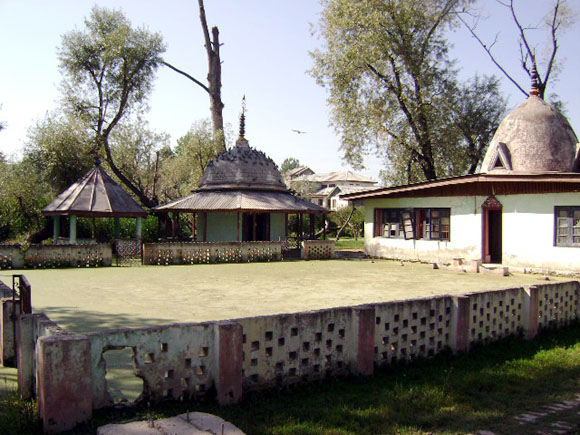
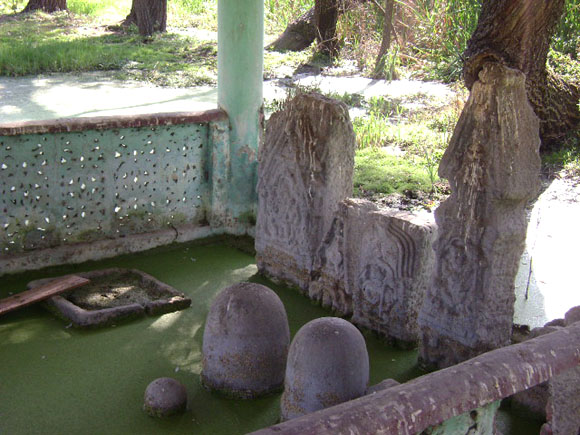
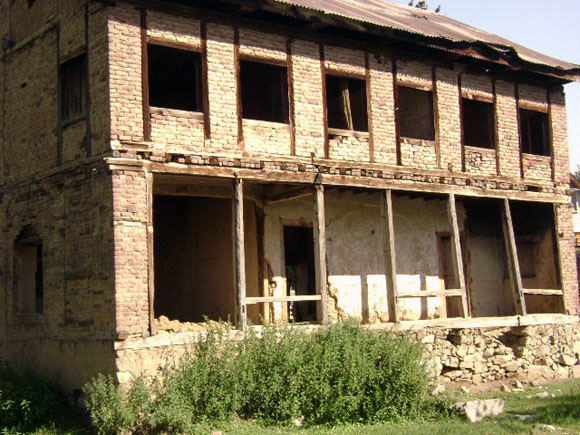
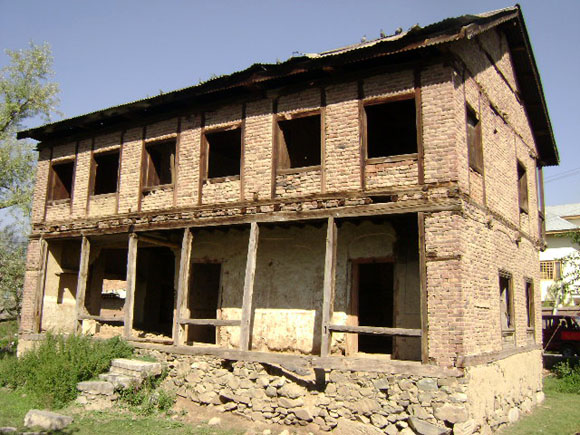
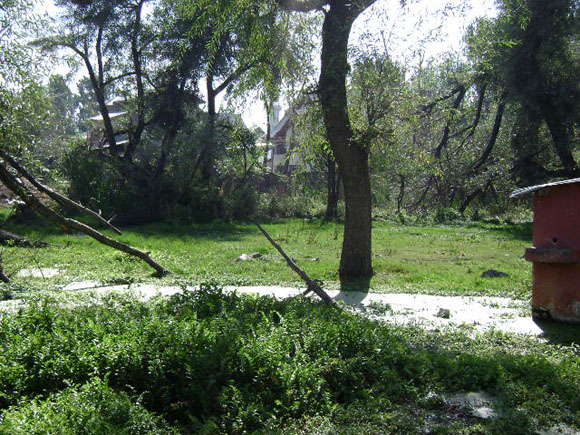
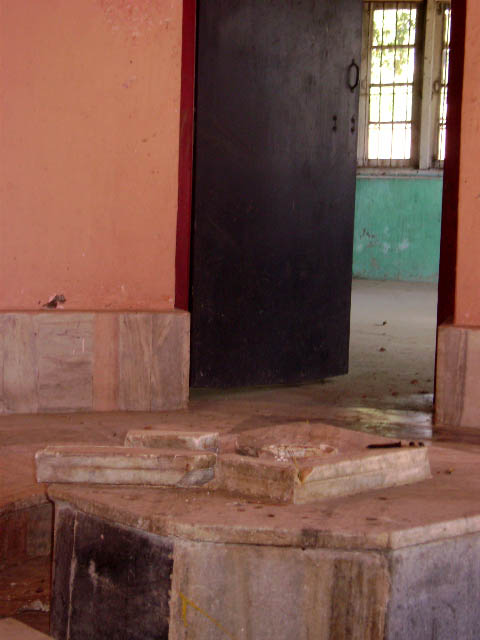
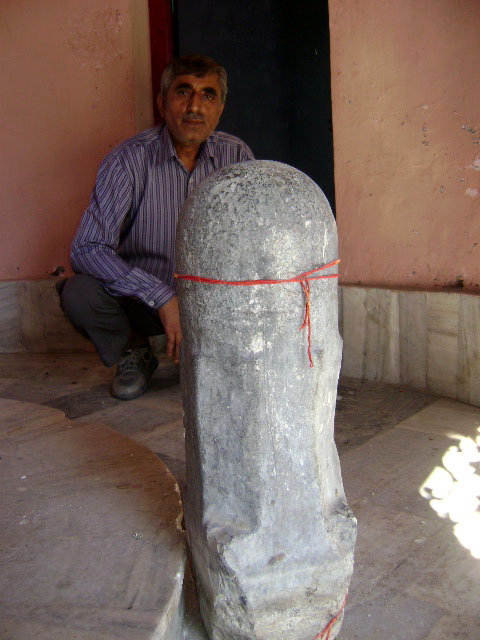

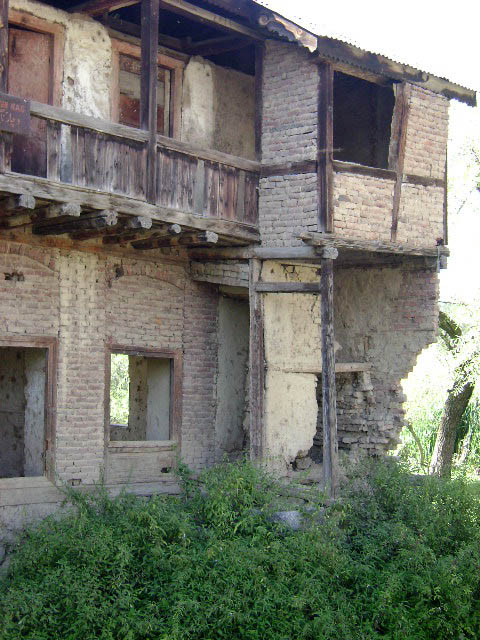
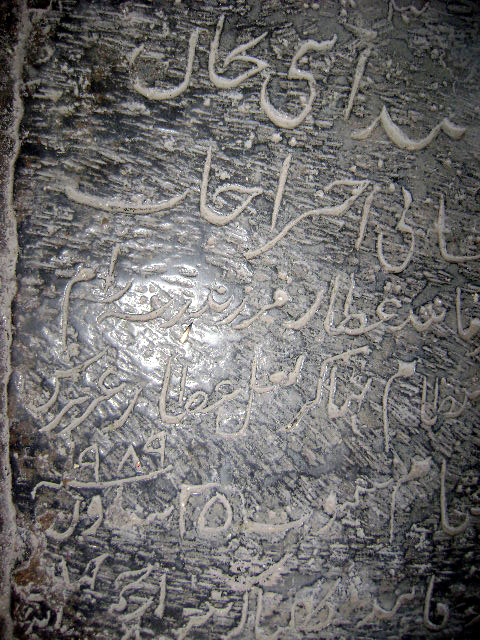
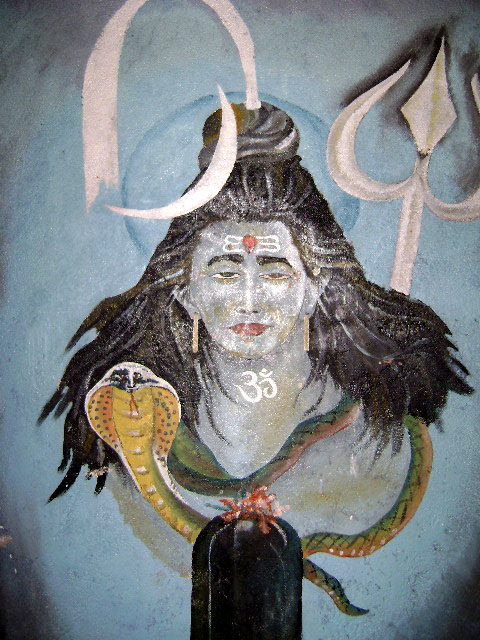
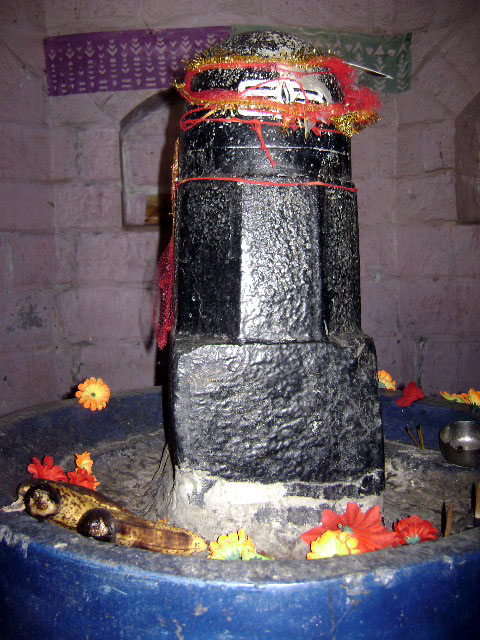
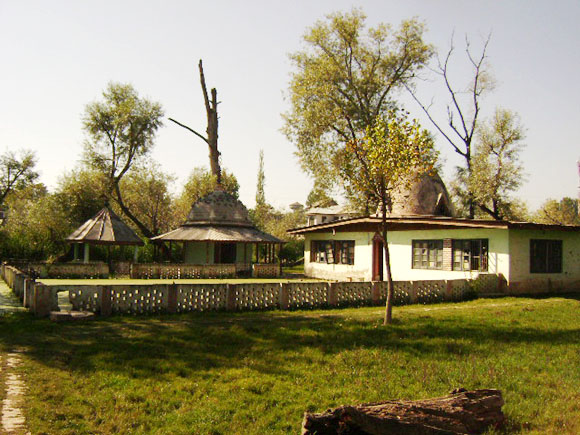
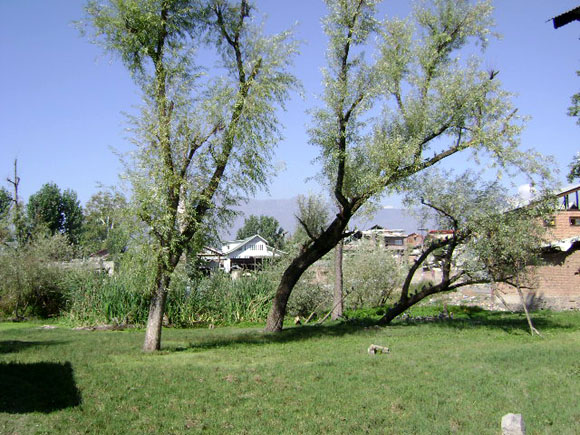
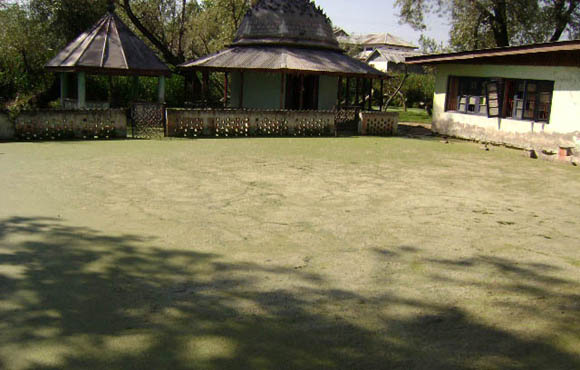
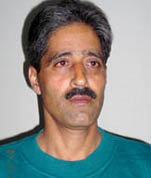 *Born
on 20th March, 1960 in Murran a village in North Kashmir, Chander M.
Bhat is presently working as an Assistant Supdt. Posts, in Department of
Posts, Govt. of India. His articles regarding Posts and of
non-political nature stand widely published in various papers and
magazines of the country. A booklet 'How to Collect Stamps" published by
the Department of Posts, has earned him genuine accolades. He worked on
the project of tracing the roots of his co-villagers and of the village
Murran, resulting into the culmination of a widely acclaimed book
"Murran -My Village". Man with depth, Chander M. Bhat has also another
book, "Ocean by Drops" (collection of poems) in his vase having colorful
poems. His book "Ancient History of Jammu and Kashmir", confirms his
researching capability. Various research papers like "The Splendor that
is Amarnath" and "Vitasta" The Sacred River of Kashmir" are valuable
additions to his works that has proved very fruitful and guiding force
in the exile period of Kashmiri Pandits community of which the author is
also a member.
*Born
on 20th March, 1960 in Murran a village in North Kashmir, Chander M.
Bhat is presently working as an Assistant Supdt. Posts, in Department of
Posts, Govt. of India. His articles regarding Posts and of
non-political nature stand widely published in various papers and
magazines of the country. A booklet 'How to Collect Stamps" published by
the Department of Posts, has earned him genuine accolades. He worked on
the project of tracing the roots of his co-villagers and of the village
Murran, resulting into the culmination of a widely acclaimed book
"Murran -My Village". Man with depth, Chander M. Bhat has also another
book, "Ocean by Drops" (collection of poems) in his vase having colorful
poems. His book "Ancient History of Jammu and Kashmir", confirms his
researching capability. Various research papers like "The Splendor that
is Amarnath" and "Vitasta" The Sacred River of Kashmir" are valuable
additions to his works that has proved very fruitful and guiding force
in the exile period of Kashmiri Pandits community of which the author is
also a member.










